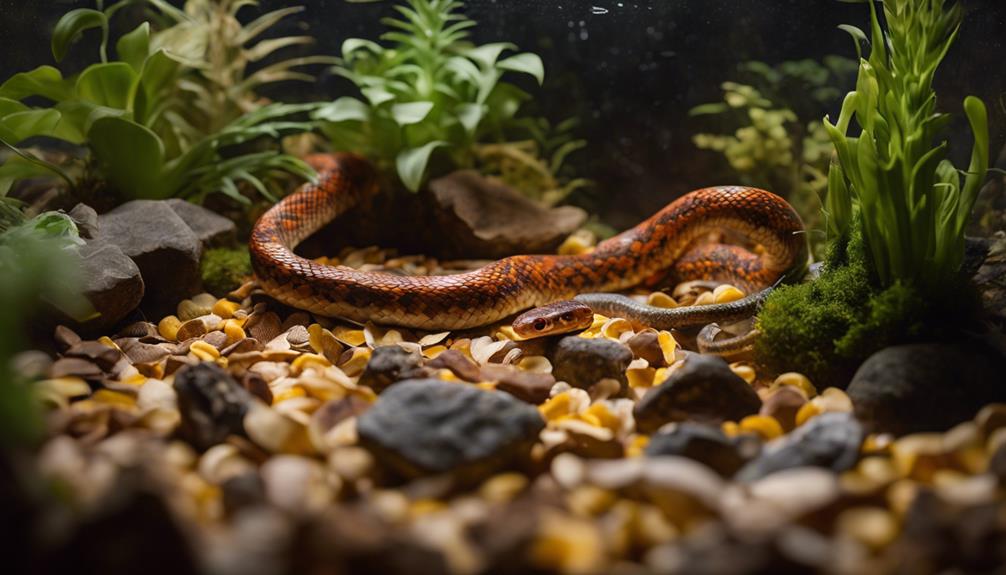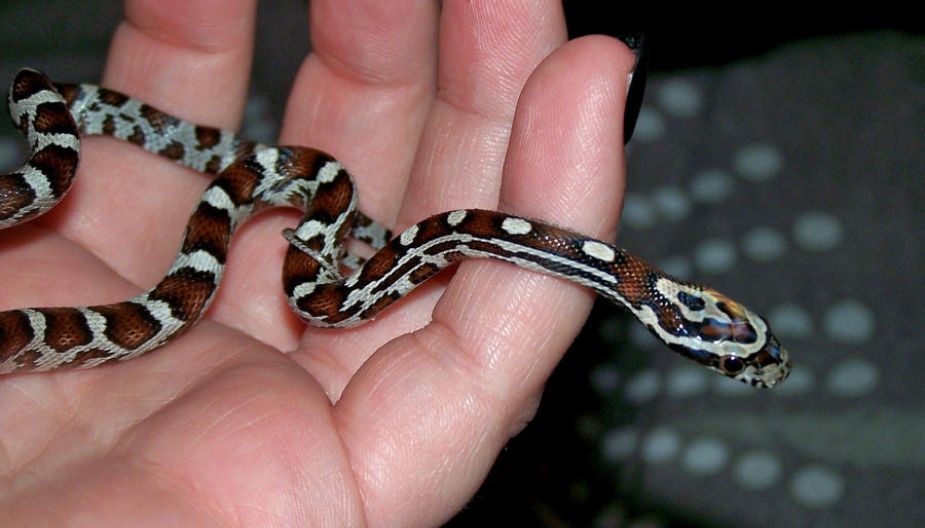Choosing the ideal substrate for your corn snake might appear daunting, but don’t worry, this guide is designed to simplify the task.
From the rich variety of naturalistic blends to the functionality of coconut fiber, each choice offers its distinct advantages.
The secret rests in recognizing your corn snake’s specific requirements and behaviors to offer them a setting that replicates their natural surroundings.
Let’s investigate together and discover the perfect bedding that will make your corn snake comfortable.
The best substrate for a corn snake is aspen, which allows for burrowing and maintains proper humidity. Aspen bedding is favored for its cleanliness and ability to mimic the snake’s natural environment.
Types of Corn Snake Substrates
When selecting substrates for your corn snake, you’ll find that various options cater to different needs and behaviors to guarantee the best care for your pet. Corn snakes thrive in environments that mimic their natural habitat, making the choice of substrate vital for their health and well-being.
Coconut fiber substrate, also known as coconut husk, is highly recommended for corn snakes due to its ability to maintain humidity levels and provide a comfortable, naturalistic setting. This substrate not only aids in creating a suitable environment but also offers enrichment opportunities for your pet.
Aspen bedding is another excellent choice for corn snakes as it allows for burrowing behavior, which is essential for their mental and physical stimulation. It’s safe for your snake’s health and provides a comfortable substrate for them to explore and hide within.
Similarly, cypress mulch is favored for its naturalistic feel and its role in maintaining proper humidity levels, ensuring your corn snake thrives in its habitat. By selecting the right natural substrate, you can promote your corn snake’s overall well-being and encourage its natural behaviors.
Pros and Cons of Each Substrate
Among the substrates commonly used for corn snakes, each option presents distinct advantages and disadvantages that cater to varying aspects of your pet’s care and environment.
Aspen bedding offers a natural appearance and the opportunity for your snake to exhibit burrowing behaviors, which is essential for their mental stimulation.
Cypress mulch, similar to coconut husk substrate, aids in maintaining the proper humidity levels necessary for your corn snake’s health.
Coconut husk substrate excels in moisture retention, supporting the natural environment of your snake.
On the other hand, using paper towels as a substrate is a temporary solution that’s easy to clean but lacks the enrichment that other substrates provide.
Reptile carpet, while easy to clean, restricts burrowing opportunities and can harbor harmful bacteria, potentially affecting your snake’s well-being.
When choosing a substrate, consider factors such as hygiene, enrichment, and the natural behaviors of your corn snake to create a comfortable and safe habitat for your pet.
Factors to Consider When Choosing
To make an informed decision on the best substrate for your corn snake, carefully consider specific factors that directly impact your pet’s health and well-being.
- Absorbency for Humidity: Opt for a substrate that can maintain proper humidity levels in the Corn Snake terrarium, essential for your snake’s shedding process and overall health.
- Dustiness and Respiratory Health: Choose a substrate with low dust levels to prevent respiratory issues in your snake, ensuring clean air quality within the enclosure.
- Reusability and Cost-Effectiveness: Look for substrates that are reusable to save on long-term costs and reduce waste, providing an environmentally friendly and budget-conscious option.
- Digestibility to Prevent Impaction: Check the digestibility of the substrate to minimize the risk of impaction in your corn snake’s digestive system, promoting proper digestion and overall well-being.
Recommended Substrates for Corn Snakes
For the best health and natural behavior expression in your corn snake, consider utilizing suggested substrates like coconut husk, aspen bedding, or cypress mulch to create a conducive environment in its terrarium.
Coconut husk stands out as a top choice due to its excellent moisture retention properties and the support it provides for burrowing activities, mimicking the snake’s natural habitat.
Aspen bedding is another recommended option that not only offers burrowing opportunities but also helps in maintaining proper humidity levels important for your corn snake’s well-being.
Additionally, cypress mulch serves as a comparable alternative to coconut husk, offering similar benefits for humidity regulation and overall comfort for your pet.
Substrates to Avoid
When selecting substrates for your corn snake enclosure, it’s important to be aware of which materials to stay away from to guarantee the safety and well-being of your pet.
- Avoid pine and cedar: These shavings contain oils that can be harmful to corn snakes if inhaled or ingested, potentially leading to respiratory issues.
- Stay away from sand: Sand can quickly mold in a humid environment, creating unsanitary conditions. Additionally, it’s challenging to clean effectively, increasing the risk of bacterial growth.
- Do not use rocks or gravel: These substrates pose a significant impaction risk for corn snakes when accidentally ingested while hunting or burrowing.
- Avoid calcium sand: While marketed as beneficial for calcium supplementation, calcium sand can be harmful if accidentally consumed by the snake, causing digestive blockages.
Proper substrate selection plays a crucial role in maintaining the well-being and safety of your corn snake, so opt for safer alternatives to ensure a healthy habitat.
Frequently Asked Questions
How Do You Make Corn Snake Substrate?
To make corn snake substrate, combine natural materials like organic topsoil, reptile soil, and play sand. Experiment with ratios for humidity control and burrowing. Maintain 3-4 inches, spot clean, and replace to guarantee safety and comfort.
How Often Should I Change My Corn Snakes Bedding?
To keep your corn snake healthy, change bedding every 3-4 months for the best hygiene. Rotate substrates, monitor humidity levels, and spot clean regularly. Proper burrowing opportunities and avoiding overfeeding can extend bedding longevity and reduce odors.
What Is the Best Setup for a Corn Snake?
For your corn snake, create a setup with proper heat sources, humidity levels, hide options, lighting requirements, cleaning routine, feeding schedule, enrichment activities, temperature gradients, water bowl placement, and substrate depth. Assure a balanced habitat for their well-being.
Can I Use Sand for My Corn Snake?
You shouldn’t use sand for your corn snake due to potential health risks like impaction. Opt for safer options like aspen or cypress mulch. Prioritize your snake’s well-being by choosing substrates that mimic their natural habitat.
Conclusion
In the end, selecting the right substrate for your corn snake is vital for their health and well-being. By considering factors like absorbency, dustiness, and ease of cleaning, you can create a comfortable and safe environment for your pet.
Remember, the substrate you choose plays a key role in mimicking their natural habitat. So, ask yourself, isn’t it worth investing in the best substrate to guarantee your corn snake thrives in their terrarium?


